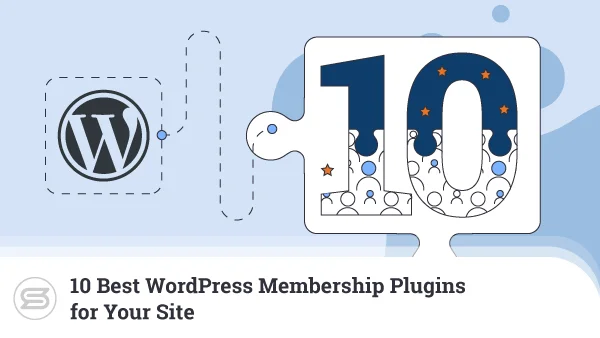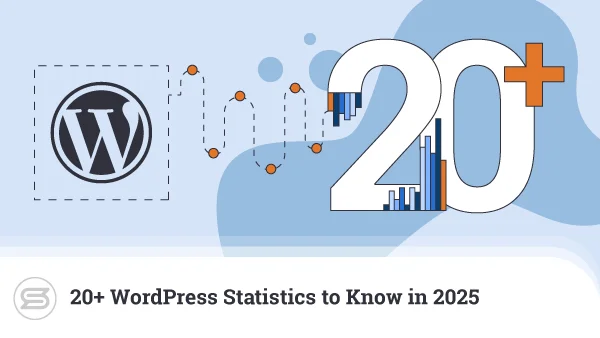Regardless of whether you’re creating a personal blog, a business website, or an online store, your site must have an easily recognizable look and feel. If you use WordPress, this means choosing the right theme.
But how do you distinguish a good WordPress template from a bad one?
A theme isn’t just a collection of files that tell the browser what your website looks like. It determines how people will navigate and access your content, so it’s critical for the overall user experience.
So, what are the best WordPress themes at the moment?
We did extensive research and tested 50+ different templates so we could shortlist the most memorable ones. We also put them through some rigorous in-house speed tests to show you how they can affect your website’s performance.
We ended up with six themes, which we’ll now go through, outlining their main advantages and showcasing their impact on loading speeds.
Let’s get to it.
GeneratePress
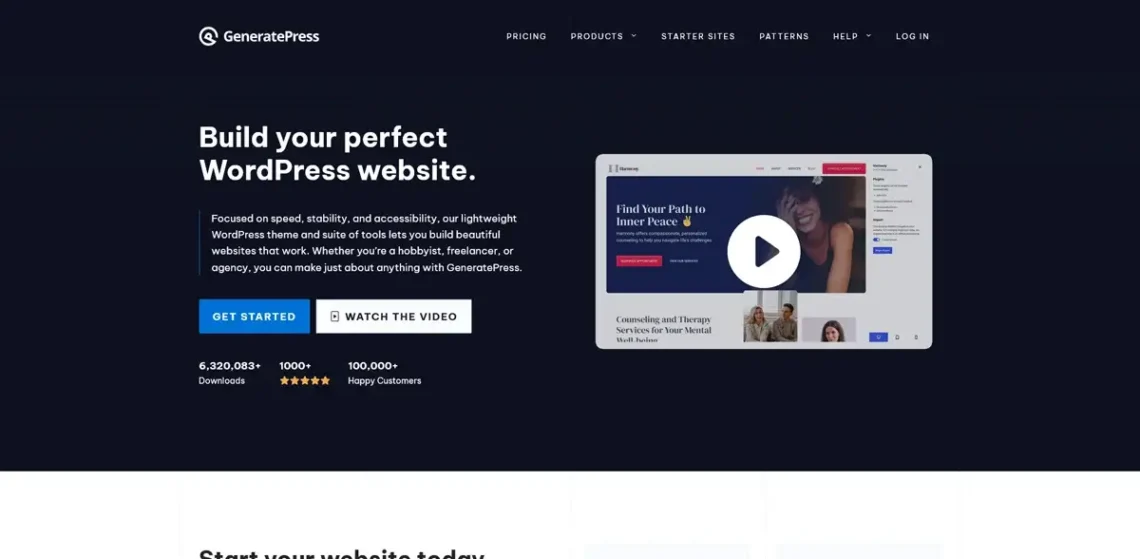
In 2014, GeneratePress was launched as an independent project by Canadian developer Tom Usborne. Right now, it’s maintained by a dedicated (albeit small) team of programmers. This shouldn’t be a surprise. According to the official repository, GeneratePress has racked up millions of downloads and has over 600 thousand active installations. There are over one thousand five-star reviews, and if you check them out, you’ll see something of a recurring theme – people seem to like GeneratePress because it’s both lightweight and versatile.
In other words, the theme has a lot to live up to. How is it coping?
Key Features
- Starter sites – GeneratePress supports an extensive library of professionally designed starter sites for everything from blogs to ecommerce shops.
- Patterns – You can use numerous ready-made templates for design elements like footers, galleries, pricing sections, etc.
- Drag-and-drop functionality – The pricier plans enable a user-friendly editor designed to help you easily create a unique website.
- WooCommerce support and web builder compatibility – GeneratePress is suitable for WooCommerce online stores and works well with website builders like Elementor.
Performance
During our performance tests, GeneratePress reached a PageSpeed Insights score of 94 on the mobile version and 98 on the desktop.
Price
The free edition available in the official repository packs plenty of features. However, there is a premium edition starting at $59 per year. More expensive packages that bundle GeneratePress’s paid version with additional tools are also available.
Kadence
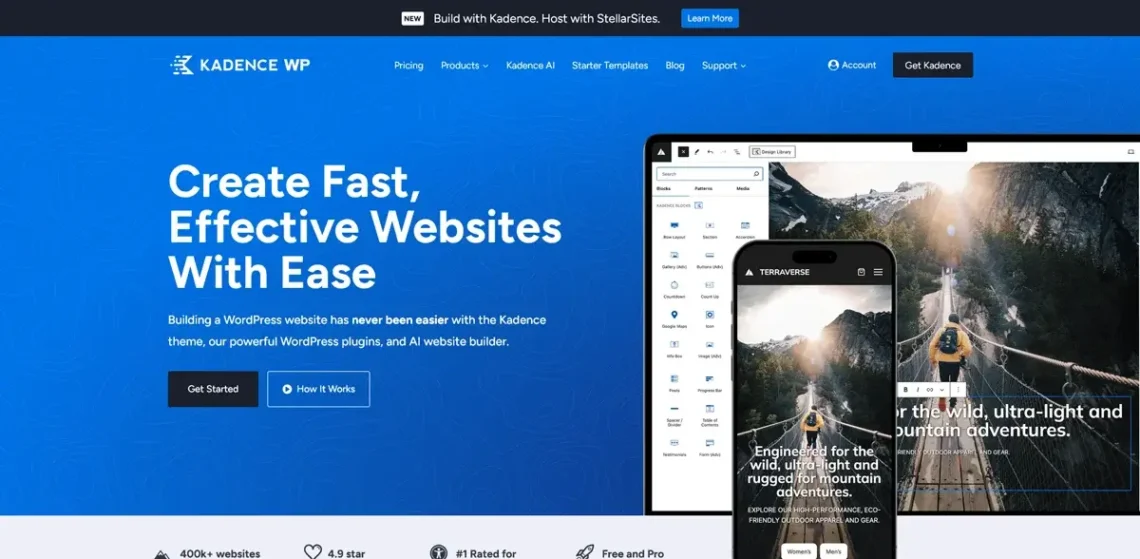
Kadence was first rolled out in 2020, but despite its young age, it has already managed to rack up over 400,000 active installations, and about 96% of the theme’s reviewers on the official WordPress repository have given it five stars.
Once you examine it in more detail, you’ll see why. The theme is loaded with features and can help anyone from an ecommerce seller to an online course creator dress their online project in a visually appealing design that improves usability and boosts sales.
It’s been praised for its flexibility and user-friendly interface. But where do all these traits come from?
Key Features
- AI integration – You can use artificial intelligence to quickly and easily set up your initial design. Once deployed, AI tools can make content suggestions and help you change the color scheme and other visual elements.
- Starter templates – You have a total of 87 templates (48 of which are free) to choose from. Each could be the perfect starting point for your unique design.
- Custom layouts – Whatever starter template you choose, you’re free to customize the size and positioning of the site’s major design elements.
- Responsive controls – You can change the site’s behavior depending on the screen size.
Performance
In our performance tests, Kadence reached a PageSpeed Insights score of 92 on mobile and 97 on desktop.
Price
Kadence’s free version is available on the official WordPress repository. There are also three premium editions, all sporting a variety of features. The cheapest one costs $69 per year and is good for up to three websites. In addition to premium support, it offers several features that aren’t available in the free version.
The mid-tier plan costs $169 per year and packs various advanced design and marketing tools. It can be used on up to 10 websites. The full bells-and-whistles version sets you back $299 per year, is suitable for up to 25 websites, and unlocks some advanced functionality that could be particularly useful for development agencies and ecommerce businesses.
Astra

Astra was first launched in 2017 by Brainstorm Force, an Indian development outfit with a rich portfolio of WordPress add-ons that includes SchemaPro, CartFlows, and Spectra, among others. In other words, it’s built by people who know what they’re doing – a point proven by the raw stats.
More than 5,800 users have given Astra five stars on WordPress’s official repository. That’s 96% of all reviews.
According to its website, Astra is employed by several internationally recognized brands, including Toyota, Mercedes-Benz, and Vodafone. It’s used on over 1.8 million websites and is widely regarded as one of the most popular themes in the entire WordPress ecosystem.
There must be a reason for all this popularity. As it turns out, there are several.
Key Features
- A range of website templates – Astra boasts a library of over 300 website templates neatly categorized according to the type of project they’re built for. Whatever you’re trying to create, you’ll find the perfect starting point for it.
- Whitelabeling – Astra has enough customization options to ensure users have no idea what theme you’re using.
- Seamless integration with popular plugins and services – Whether you’re using an add-on like WooCommerce, a site builder like Elementor, or a third-party service like Stripe, you’ll have no problems integrating everything with the Astra-built design.
- Video tutorials – Brainstorm Force has a YouTube playlist with over 80 videos detailing Astra’s greatest features and showing you how to make the most of the theme.
Performance
During ScalaHosting’s performance tests, Astra scored a PageSpeed Insights score of 71 on the mobile version and 95 on the desktop one.
Price
Like most other entries on our list, Astra’s free version is available on the official WordPress repository and can be installed straight from the WP dashboard. The Pro edition includes a range of built-in layouts, advanced WooCommerce integration, a site builder, dedicated customer support, and many more. The annual subscription costs $49, but you can also have it for a lifetime licensing fee of $199. Brainstorm Force has a few packages that bundle Astra with the rest of the company’s add-ons.
Blocksy
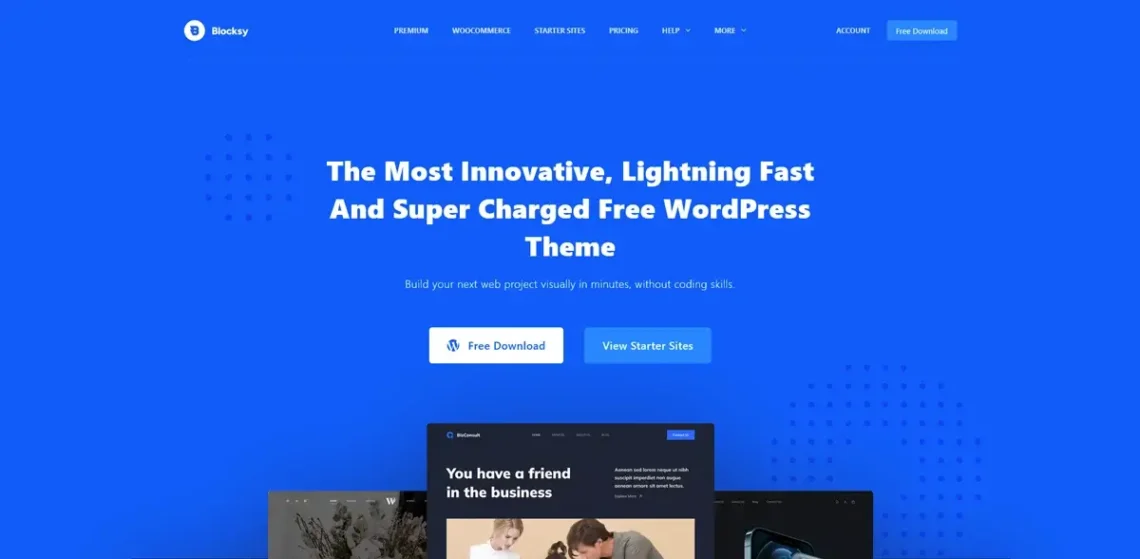
Blocksy is fully integrated with the Gutenberg editor, and it introduces dozens of new blocks that give you more freedom over how different design elements look and where they’re positioned. Thanks to the array of new blocks, Blocksy can help you build anything from a personal blog to a large-scale ecommerce store. There’s no shortage of starter site templates, ensuring your project’s wheels are turning as soon as possible.
At the time of writing, Blocksy has over 200,000 active installations. What’s more impressive, however, is that of the 855 users who have left reviews of the theme on WordPress.org, only 10 have given it less than five stars.
So, why do people love it so much?
Features
- Advanced typography options – Blocksy provides an easy interface for applying typography modifications both site-wide and for individual sections.
- Individual layouts for different post listings – Blocksy allows you to customize the look of individual post listings using five available archive layouts.
- One-click importer – You can easily import pages, posts, and widgets from other themes with the help of Blocksy’s built-in importer.
- Site builder-friendly – Blocksy may be fully integrated with Gutenberg, but this doesn’t mean it doesn’t work well with other site builders. On the contrary, it’s fully compatible with the most popular add-ons of this kind.
Performance
During our tests, Blocksy reached a PageSpeed Insights score of 78 on the desktop version, which is reasonable. However, on mobile screens, the score of 45 was somewhat disappointing.
Price
In addition to the free edition, Blocksy offers a pro version in three guises – Personal, Business, and Agency. The paid themes cost $69/year ($199/lifetime), $99/year ($299/lifetime), and $149/year ($499/lifetime), respectively, and they offer various tools that could be useful for businesses, ecommerce site owners, and development agencies. The free version should be good enough for most individual users.
Divi
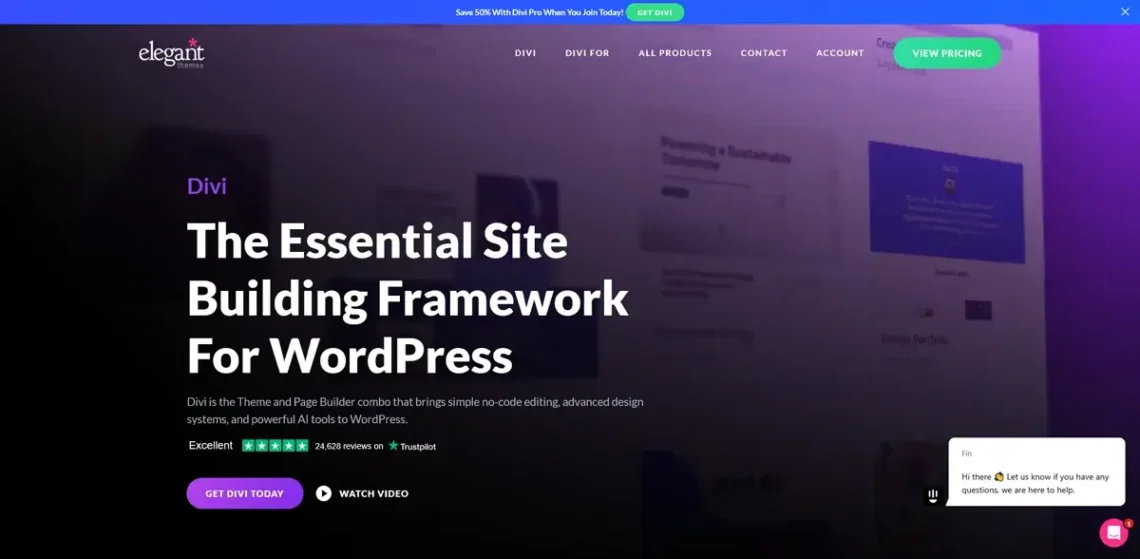
When it launched in 2013, Divi included a backend layout editor that was more flexible than what other themes offered. A couple of years later, Elegant Themes, Divi’s creator, rolled out the Divi Builder plugin with a graphical interface for editing ready-made designs. In 2016, the builder was integrated into Divi itself. Right now, Divi is more of a development framework than a theme.
It’s famous for its visual builder, but it also feeds off a huge online community that provides various extensions and solutions to make it more functional and versatile. The idea is that both complete newcomers and seasoned WordPress users should be able to launch their projects with minimum effort.
Key Features
- A Drag-and-Drop builder – Divi has a visual editor offering a full what-you-see-is-what-you-get experience.
- Layout packs – Divi has a massive library of layouts suitable for anything from yoga studios to law firms.
- Custom WooCommerce modules – Divi is not only compatible with WooCommerce, but it also offers special modules that enhance product pages and improve the shopping experience.
- AI tools – Divi recently introduced new artificial intelligence utilities that help you get started more quickly. The only downside is that they’re only available with the Divi Pro plan.
Performance
All these extra features may streamline the website-building process, but they are taking a toll on Divi’s performance. During our tests, it reached a PageSpeed Insights score of just 41 on mobile devices and 83 on desktop screens.
Price
Unlike the rest of the themes on our list, Divi doesn’t have a free version. The theme and builder are available for $7.42 per month or a one-time fee of $249. The Divi Pro membership unlocks Divi’s AI tools and includes goodies like cloud storage, premium support, and discounts for the Divi Marketplace. At the time of writing, the Divi Pro plan costs $23.08 per month or $297 if you want a lifetime subscription.
Hello Elementor
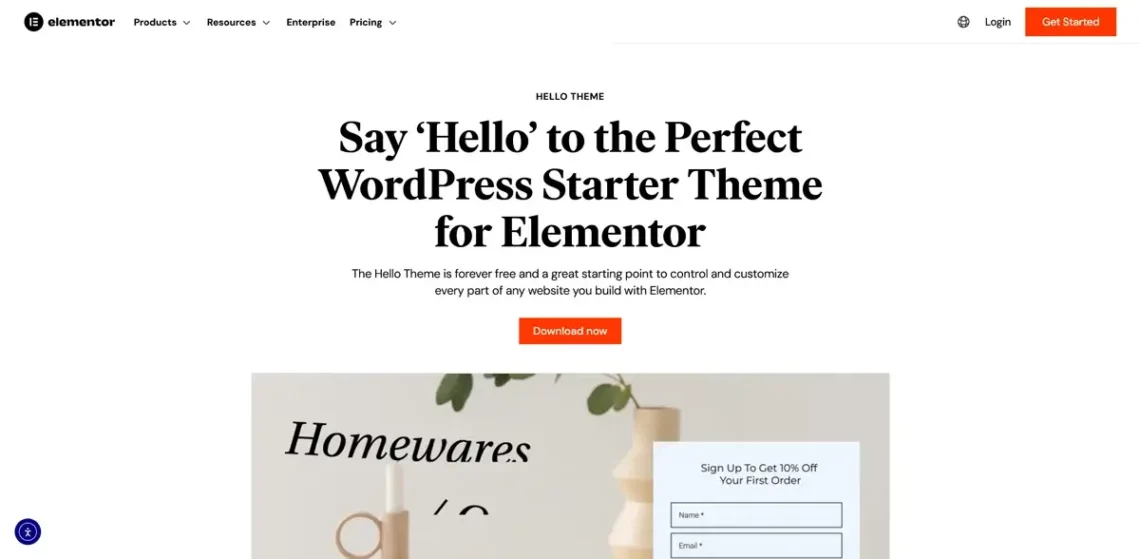
Hello is available in the official WordPress repository, and you can install it just like any other run-of-the-mill theme. However, that’s not how you’re supposed to use Hello.
Hello is the official starter theme of Elementor – the most popular website builder in the WordPress ecosystem. The idea is to install the theme and modify it using Elementor’s visual editor.
Hello delivers a no-fuss look out of the box. The design is clean, and there aren’t many features to play with. You’re supposed to add all the elements that transform your site’s user experience through Elementor. But does it really work?
According to WordPress.org, Elementor has over 10 million active installations, and the Hello theme is used on more than 1 million websites. Quite a lot of people clearly enjoy working with this particular setup. Here’s why.
Key Features
- Minimal design – Some may consider the lack of default features a drawback, but the truth is, Hello’s idea is to act as a blank canvas that you’ll use to build your design.
- WooCommerce support – The Hello theme can even be the base of your new online store.
- Developer-friendly – Thanks to the clean codebase, programmers can easily extend the site’s functionality by implementing features via a child theme.
- Perfect Elementor compatibility – Hello and Elementor are designed to work together. This allows you to take full advantage of the site builder’s features and create a unique design.
Performance
The Hello theme offers a clean look, suggesting quick loading speeds. However, to unlock its true potential, you must use Elementor – a complex, resource-intensive plugin. This reflected the theme’s performance during our tests. Elementor’s Hello scored a PageSpeed Insights score of 45 on mobile and 69 on desktop.
Price
The Hello theme is free and available on the official WordPress website. Elementor can also be downloaded from WordPress.org free of charge. However, the site builder also offers several premium editions with more features and extras. The prices start at $4.99 per month and go up to $16.99 per month.
Why Performance Matters and How to Improve It
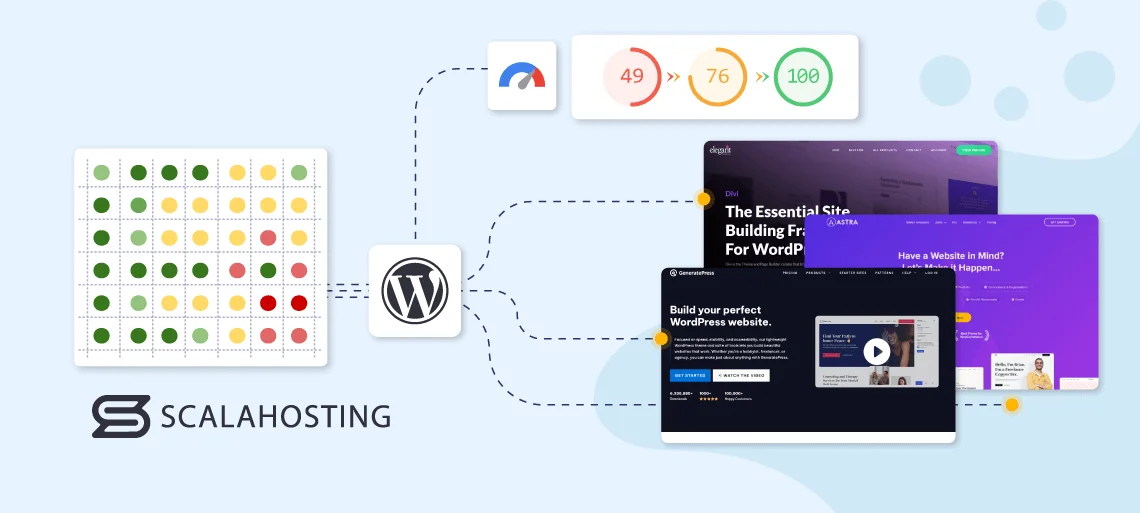
The overviews above showcase how different individual WordPress themes can be. The results they reached during our performance tests were equally diverse.
The experiment was as thorough as it could be. We took an SPanel VPS and set up multiple WordPress installations. Each of our chosen themes was deployed on its own WordPress site, and because we wanted to isolate the theme’s impact on website performance, there were no additional add-ons.
The virtual server had just 1 CPU core and 2GB of RAM. The idea was to make the results relevant to the people who are more likely to experience performance issues – those on underpowered servers and shared solutions.
We used a default setup – Apache with PHP 8.1.32, GZIP compression, PHP OpCache, and a 512MB PHP memory limit. To show you just how much of a difference a theme can make, we also tested a clean WordPress installation with the default Twenty Twenty-Five theme as a benchmark.
We used PageSpeed Insights’s API on a headless Chrome browser because we wanted to see how the different themes score in the crucial Google Core Web Vitals metrics.
We focus on them partly because they’re a significant search engine ranking factor but mostly because they can seriously influence your site’s user experience. More specifically, our points of interest were the Total Blocking Time (TBT), the First Contentful Paint (FCP), the Largest Contentful Paint (LCP), the Cumulative Layout Shift (CLS), and the Speed Index.
Every test was conducted three times, and the average results are compiled in the table below.

NOTE: The first results in each cell are for mobile, and the second for desktop versions.
The table shows that even some of the most popular WordPress themes can slow your site down. The good news is, there are several steps you can take to tweak your hosting environment and neutralize all those negative effects.
Here are a few tips.
- Switch to LiteSpeed or OpenLiteSpeed web server
The Apache web server has been around for about thirty years now, and its age is starting to show. Its process-based architecture has disadvantages that become obvious as soon as traffic picks up. Luckily, there’s an alternative.
LiteSpeed Web Server (LSWS) and its open-source counterpart, OpenLiteSpeed, have a more modern, scalable, and performance-optimized design than Apache. They don’t spawn a new process for every connection and can, therefore, serve content much more quickly while keeping server load to a minimum.
In addition to the event-driven architecture, LSWS and OpenLiteSpeed offer faster PHP processing, more efficient static content delivery, and a powerful built-in cache engine.
Crucially, you can take advantage of all these benefits without making significant changes to your site. As a WordPress user, all you’ll need to do is install the free LiteSpeed Cache plugin, which will ensure your site is optimized to work with the faster web server.
- Optimize your images
Large images affect loading speeds regardless of the screen size, but they’re especially damaging when the website is viewed on a mobile device. This is why some of the image-heavy designs showed significant discrepancies between their mobile and desktop performances during our tests.
Thankfully, the WordPress community has built a number of plugins that help you mitigate this. Caching and performance-enhancing add-ons like ShortPixel Image Optimizer, Imagify, and Optimole can automatically resize your images, convert them to a more performance-oriented format, strip EXIF data, etc. The effects on the overall performance and resource usage will be enormous.
- Use a CDN (Content Delivery Network)
A content delivery network copies your site’s static data (such as images, CSS stylesheets, JavaScript files, etc.) and stores them on servers situated in multiple locations worldwide. When a user wants to load your website, the static files are delivered from the server that is physically closest to them.
On the one hand, this lowers the load on your primary hosting server because it no longer needs to process static data. On the other, it reduces the geographical distance information needs to travel before it reaches the user’s screen.
The upshot is your website loads much more quickly, and as an added bonus, your CDN service increases your resilience to DDoS attacks and other threats.
It all sounds very complicated and expensive, but it’s not.
It’s 2025, and many providers offer a fully fledged CDN service for free. Some solutions, like Jetpack CDN and jsDelivr, specialize in delivering specific types of static data. If you’re looking for a general-purpose CDN, however, you’ll most likely do what the owners of 24 million other websites have done and use Cloudflare.
The steps to activate a CDN service on your website depend on the provider itself, but in the case of WordPress, it’s usually done either via your web hosting control panel or through a plugin.
- Consider installing a caching plugin
Pretty much all of the techniques listed above can be implemented with the help of plugins like WP Rocket and WP Fastest Cache. They’re formally known as caching plugins, but over the years, they’ve grown into all-in-one performance optimization solutions that incorporate an entire suite of tools.
In addition to what we’ve already mentioned, they can minify your site’s CSS, JS, and HTML files, shrinking the page size and improving performance. They can also optimize the database, enable preloading, configure WP’s lazy loading mechanisms, scan for dormant plugins and excessive external requests, etc.
All these affect your Core Web Vitals scores and can be transformative to your project’s future.
- Find a suitable web hosting service
All the effort you put into speeding up your WordPress website will be futile if you’ve deployed it in the wrong hosting environment.
Choosing between all the different setups and hosts can be tricky, but after nearly 20 years of hosting thousands of successful WordPress projects, we reckon we have a solution for everybody.
ScalaHosting: The Best Hosting Environment For a Good-Looking, Fast WordPress Website
In addition to our standard plans, we offer a range of WordPress hosting solutions aimed specifically at users of the world’s most popular CMS. Our goal isn’t merely to provide the best possible hosting environment. We also want to ensure our plans fit projects of all shapes and sizes.
So, if you’re starting a new website and you are looking for the fastest WordPress hosting services, look no more.
All packages offer a one-click installer that sets up the CMS for you in seconds, and they arrive pre-configured for the best possible performance and security.
Of course, the shared environment has some limitations. Once your website grows, you can upgrade to one of our cloud virtual private servers for WordPress.
The guaranteed resources and isolated environment will give you better, more consistent performance, and the dedicated IP improves email deliverability and security. Our state-of-the-art infrastructure allows you to tailor your VPS configuration to your specifications.
You can choose the exact amount of processing power, memory, and storage for the VPS and upgrade the configuration whenever needed. You get infinite scalability, so no matter how big your project grows, you can always expect excellent performance and reliability.
ScalaHosting’s WordPress plans are fully managed, so you don’t need to worry about core server settings or configurations. Instead, you can install WordPress and manage your site via SPanel – a web hosting control panel built by ScalaHosting and designed to give you all the tools you need, including utilities that enable LSWS or OpenLiteSpeed and integrate your website with the Cloudflare CDN in a couple of clicks.
When it comes to WordPress, every aspect of the site’s development is considered, including the process of choosing a theme. Thanks to the unique WordPress Manager, you can easily set up a theme during the initial WP installation and create multiple staging environments to thoroughly test several designs before picking the one that best fits your needs.
Conclusion
Your WordPress theme plays a huge role in how people view your website and your business. The enormous WordPress ecosystem means you’re pretty much spoilt for choice when picking your site design.
It doesn’t make the decision any easier, though. On the contrary, if you want to choose the best WordPress theme, you have to consider multiple factors, including how it affects not only the site’s design but also its performance.
FAQ
Q: What is the fastest WordPress theme?
A: Generally, themes that use many images and resource-heavy media files tend to be slower than cleaner designs with fewer features. Having tested dozens of WP themes, we found that the default Twenty Twenty-Five theme and GeneratePress showed the best loading speeds. At the other end of the spectrum, you have designs built around page builders like Divi and Hello Elementor. They tend to offer more customization options, but reaching decent loading speeds with them will require more optimization.
Q: How can I improve my WordPress site performance?
A: There is no algorithm you can follow to guarantee excellent loading speeds, but you can do quite a few things to improve your performance and user experience. Make sure you deploy your site in a suitable hosting environment, remove any plugins and themes you’re not using, and pick an effective caching solution to boost speeds.
Q: Is there a better CMS than WordPress?
A: WordPress is by far the world’s most popular content management system. However, this doesn’t mean it will work perfectly for all users. Before you pick a platform for your website, check its requirements, review the various features, and see which one best suits your needs.

